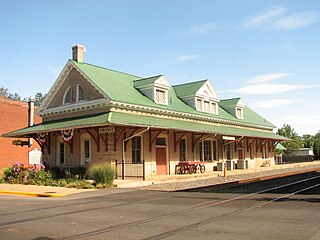
Orange is a town and the county seat of Orange County, Virginia, United States. The population was 5,062 at the 2020 census, representing a 7.2% increase since the 2010 census. Orange is 28 miles (45 km) northeast of Charlottesville, 88 miles (142 km) southwest of Washington, D.C., and 4 miles (6 km) east of Founding Father and fourth U.S. president James Madison's plantation of Montpelier.

Courtland is an incorporated town in Southampton County, Virginia, United States. It is the county seat of Southampton County.
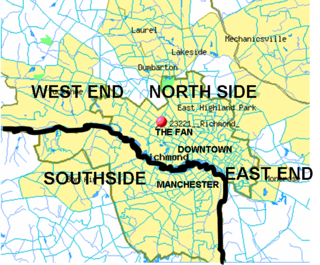
Manchester is a former independent city in Virginia in the United States. Prior to receiving independent status, it served as the county seat of Chesterfield County, between 1870 and 1876. Today, it is a part of the city of Richmond, Virginia.
William Augustus Edwards, also known as William A. Edwards was an Atlanta-based American architect renowned for the educational buildings, courthouses and other public and private buildings that he designed in Florida, Georgia and his native South Carolina. More than 25 of his works have been listed on the National Register of Historic Places.
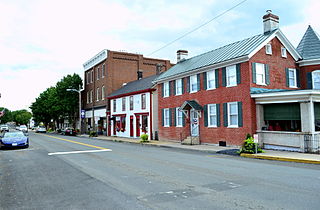
Strasburg Historic District is a national historic district located at Strasburg, Shenandoah County, Virginia. The district encompasses 206 contributing buildings and 1 contributing site in the town of Strasburg. It includes a variety of commercial, residential, and institutional buildings dating from the 18th to 20th centuries. Notable buildings include the George Eberly House, Presbyterian Church, Alton House, Spengler Hall, Spengler's Mill (1794), Bell Pottery (pre-1878), Strasburg Christian Church, Strasburg Methodist Church (1905), St. Paul's Lutheran Church (1892), First National Bank, Home Theatre (1930s), Strasburg School (1910) and the Sonner House (1757).

Richlands Historic District is a national historic district located at Richlands, Tazewell County, Virginia. The district encompasses 91 contributing buildings in the central business district of the town of Richlands. It includes residential, commercial, and institutional buildings dating from the late-19th to mid-20th centuries. Notable buildings include the W.B.F. White and Sons Hardware building, Bank of Richlands, Norfolk and Western Railroad Section House, First Christian Church (1908), First United Methodist Church, and Richlands Presbyterian Church. Also located in the district is the separately listed Clinch Valley Coal and Iron Company Office.
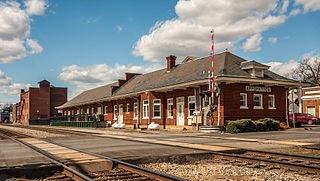
The Appomattox Historic District national historic district located at Appomattox, Appomattox County, Virginia. It contains 297 contributing buildings, 6 contributing structures, and 3 contributing objects in Appomattox. It includes Courthouse Square, the commercial district surrounding the railroad tracks, the Appomattox depot (1923), and surrounding residential areas dating back to the 19th century. Notable buildings include the Appomattox Courthouse (1892), Appomattox County Jail (1895-1897), County Office Building (1940), Knickerbocker Hotel (1892), Bank of Appomattox (1906), Appomattox Middle School (1908), Appomattox Pentecostal Holiness Church, and "The Nebraska House".

Accomac Historic District is a national historic district located at Accomac, Accomack County, Virginia. The district encompasses 158 contributing buildings in the town of Accomac, mainly grouped into two periods of construction. From its founding in 1786 through the second quarter of the nineteenth century, several residential, commercial, governmental, and religious structures were built in the core of Accomac, representing both high-style and vernacular examples of late Georgian, Federal, and Greek Revival styles. Notable structures surviving from this period include the rectory of St. George's Episcopal Parish ; the Seymour House (1791-1815); Roseland (1750-1850); Seven Gables (1786-1905); Rural Hill, and the Francis Makemie Presbyterian Church (1840). The second period of construction reflected in the town dates to the last quarter of the nineteenth century, when the arrival of the New York, Philadelphia, and Norfolk Railroad spawned renewed growth and economic prosperity in Accomack County following the Civil War. These buildings also display both high-style and vernacular expressions of Victorian Era styles, including Second Empire, Italianate, Gothic Revival, and Romanesque. Notable structures from this time period include Bayly Memorial Hall, the County Clerk's Office (1887), the Accomack County Courthouse (1899), and houses found in the Lilliston Avenue extension of the town built in the 1880s-1890s. There are also contributing structures dating from the first quarter of the twentieth century, including the Drummondtown Baptist Church (1914), Drummondtown United Methodist Church (1920), and the former hotel at the town square (1925).
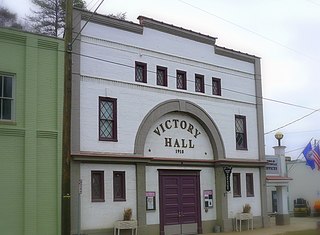
Scottsville Historic District is a national historic district located at Scottsville, Albemarle County and Fluvanna County, Virginia. The district encompasses 153 contributing buildings, 1 contributing site, and 4 contributing structures in the town of Scottsville. The district includes commercial, residential, religious, factory and warehouse buildings in a variety of popular architectural styles including Federal, Georgian, Greek Revival, Gothic Revival, Italianate, Queen Anne, Prairie, Colonial Revival, and Craftsman. Notable buildings include Scottsville High School (1920), Riverview (1817), Chester (1847), Belle Haven, Oakwood, Herndon House (1800), The Tavern (mid-1700s), Scottsville Presbyterian Church (1832), Disciples Church (1846), Coleman's Store (1914), and the Fore House (1732). Located in the district and separately listed are Cliffside and Mount Walla.

Berryville Historic District is a national historic district located at Berryville, Clarke County, Virginia. It encompasses 313 contributing buildings and 1 contributing object in the town of Berryville. They include a variety of residential, commercial, and industrial buildings dating from the late 18th century to the 1930s. Notable buildings include the Treadwell Smith House, Sarah Stribling House, Crow's Nest (1830s), Berryville Presbyterian Church, Grace Episcopal Church (1857), Coiner's Department Store, Clarke Milling Company, H. W. Baker Grain Warehouse, H. B. Whiting Brothers Warehouse, Berryville railroad depot (1910), the First National Bank, the Farmers and Merchants National Bank, and the U.S. Post Office (1938). The contributing object is the Clarke County Confederate Memorial on the grounds of the courthouse. Located in the district and separately listed is the Old Clarke County Courthouse.
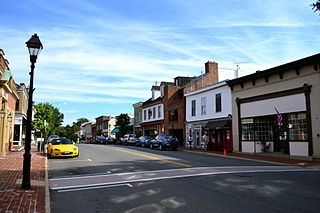
Warrenton Historic District is a national historic district located at Warrenton, Fauquier County, Virginia. It encompasses 288 contributing buildings in the central business district and surrounding residential areas of the county seat of Warrenton. Notable buildings include the old Fauquier County courthouse (1890), Fauquier County Administration Building (1928), the former Fauquier County Public Library (1923), Fauquier National Bank (1925), "Paradise" (1758), the Thomas L. Moore House (1816), the James Caldwell House (1831), the John Quincy Marr House (1830), the Marshall Building, the California Building, old Town Hall (1854), Warrenton Presbyterian Church (1855), Ullman's Store, and "Mecca" (1859). Also located on the district are the separately listed Brentmoor and Old Fauquier County Jail.

Town of Halifax Court House Historic District is a national historic district located at Halifax, Halifax County, Virginia. The district includes 172 contributing buildings, 1 contributing site, 13 contributing structures, and 1 contributing object in the Town of Halifax. Resources include government, commercial, residential, religious, educational and industrial buildings that date from the early-19th Century to the mid-20th century. Notable buildings include the Rice House, Edmunds/Lewis Office (1869), People's Bank, Beth Car Baptist Church (1892), Christ Episcopal Church, Saint Luke's Christian Methodist Episcopal Church, Dr. Carter House, County Office Building (1915), Town of Halifax Swimming Pool (1930s), Municipal Building/ Fire Station (1950), Halifax Roller Mills (1915), Halifax Planing Mill, Halifax Department Store (1949), and Randolph Theater. Also located in the district is the separately listed Halifax County Courthouse.

Smithfield Historic District is a national historic district located at Smithfield, Isle of Wight County, Virginia. It encompasses 289 contributing buildings and 2 contributing structures in the historic downtown and surrounding residential areas of Smithfield. There are 211 houses, 37 commercial buildings, 1 warehouse, 4 churches, 10 barns, 1 smokehouse, 23 garages, 1 farm office, 1 colonial kitchen, and 2 corncrib structures. Notable buildings include the original county clerk's office (1799), county jail, Wentworth-Barrett House, Wentworth–Grinnan House, King-Atkinson House, Smith-Morrison House (1770s), Hayden Hall, Boykin House, Goodrich House (1886), Thomas House (1889), Smithfield Academy (1827), Christ Episcopal Church, and Hill Street Baptist Church (1923). Located in the district and separately listed are the Old Isle of Wight Courthouse, Smithfield Inn, Windsor Castle Farm, and P. D. Gwaltney Jr. House.

Chatham Historic District is a national historic district located at Chatham, Pittsylvania County, Virginia. The district includes 188 contributing buildings, 2 contributing sites, and 1 contributing object in the central business district of the town of Chatham. The district includes a variety of government, commercial, residential, religious and educational buildings and structures dating from the early-19th century to the mid-20th century. At the center of the district is the separately listed Pittsylvania County Courthouse. Other notable buildings include the Judge Tredway House, Tunstall-Hargrave House, The Oaks (1832), Morea (1837), Hugh Weir House (1835), Planter's Bank, Thompson's Drug and Haberdashy Building, Corinth Christian Church, Emmanuel Episcopal Church (1881), Chatham Presbyterian Church (1886), Canada-Melton House, United States Post Office, Chatham High School, Chatham Elementary School (1925), Chatham Savings Bank, Masonic Temple, Collie Hotel/William Pitt Hotel, Beauty Plaza, and the Moses Building. Also located in the district and separately listed are the Clerk's Office, Bill's Diner, and Burnett's Diner.

Marion Historic District is a national historic district located at Marion, Smyth County, Virginia. The district includes 361 contributing buildings, 2 contributing sites, and 1 contributing object in the central business district and surrounding residential areas of Marion. It includes a variety of residential, commercial, institutional, industrial, and governmental buildings primarily dating from the mid-19th to mid-20th centuries. Notable buildings include the Sheffey Loom House, Odd Fellows Lodge, Look & Lincoln Wagon Factory warehouse, the Beaux-Arts style Marion County Courthouse (1905), Mt. Pleasant Methodist Church, Courtview Building (1890s), Marion High School (1907-1908), Marion Junior College (1912), the Overall Factory, Weiler Building, Bank of Marion (1922), Royal Oak Presbyterian Church (1923), Marion Municipal Building (1935), Marion Post Office (1936), and a Lustron house (1948). Also located in the district are the separately listed Hotel Lincoln, Lincoln Theatre, Marion Male Academy, and Norfolk & Western Railway Depot.

Front Royal Historic District is a national historic district located at Front Royal, Warren County, Virginia. The district encompasses approximately 470 contributing buildings and structures in the town of Front Royal. It has a mix of commercial, residential, industrial, religious and governmental buildings dating from the late-18th to mid-20th centuries. Notable buildings include the former Proctor-Biggs Mill, a former apple warehouse, Murphy's Theater (1908-1909), Compton's Corner, first Bank of Warren, Trout Drugstore Building, second Bank of Warren building (1914), Montview Hotel, Park Theater, the Henry Trout House, Mullen-Trout House, Giles-Cooke House, and the Dr. Manly Littleton Garrison. Located in the district and separately listed are the Balthis House and Warren County Courthouse.
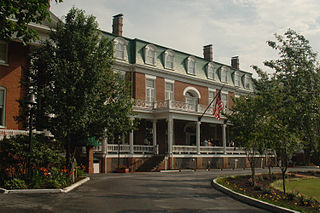
Abingdon Historic District is a national historic district located at Abingdon, Washington County, Virginia. The district encompasses 145 contributing buildings, 2 contributing site, and 13 contributing structures in the town of Abingdon. It includes a variety of residential, commercial, and institutional buildings dating from the late-18th century to the mid-20th century. Notable contributing resources include Sinking Spring Cemetery, William King High School (1913), General Francis Preston House (1832), Martha Washington Inn, Barter Theatre, the Virginia House, Alexander Findlay House (1827), Gabriel Stickley House, Ann Berry House, Washington County Courthouse (1868), Rev. Charles Cummings House, and James Fields House (1857). Located in the district and separately listed are the Abingdon Bank and Dr. William H. Pitts House.

Charlottesville and Albemarle County Courthouse Historic District, also known as the Charlottesville Historic District is a national historic district located at Charlottesville, Virginia. The district encompasses the previously listed Albemarle County Courthouse Historic District and includes 269 contributing buildings and 1 contributing object in the city of Charlottesville. It includes the traditional heart of the city's commercial, civic, and religious activities, with early residential development and industrial sites located along the fringe. The commercial core is located along a seven block Downtown Mall designed by Lawrence Halprin (1916-2009). Notable buildings include the Albemarle County Courthouse, Levy Opera House, Number Nothing, Redland Club, Eagle Tavern, United States Post Office and Courts Building (1906), Christ (Episcopal) Church (1895-1898), Beth Israel Synagogue (1882-1903), Holy Comforter Catholic Church (1925), First Methodist Church (1924), McIntire Public Library (1919-1922), and Virginia National Bank (1916). Also located in the district are the separately listed Abell-Gleason House, William H. McGuffey Primary School, Thomas Jonathan Jackson sculpture, Robert Edward Lee sculpture, and Marshall-Rucker-Smith House.
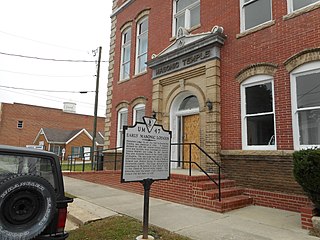
Hicksford–Emporia Historic District, also known as Emporia, is a national historic district located at Emporia, Virginia. The district includes 36 contributing buildings and 2 contributing objects in the Hicksford section of Emporia. In 1848, Hicksford was a stop on the Petersburg Railroad. In 1887, the neighboring towns of Hicksford and Belfield merged to form the town of Emporia. The district generally consists of late 19th century or early 20th century, when Hicksford–Emporia began to evolve from a small agricultural outpost to a large commercial and governmental center. Located at the heart of the district is the separately listed Greensville County Courthouse Complex. Other notable buildings include the Citizen's National Bank, the Widow's Son's Masonic Lodge (1905), First Presbyterian Church (1907-1908), Emporia Elementary School, Emporia Armory (mid-1930s), Greensville County Auditorium (1934), and Emporia Post Office (1938). The Old Merchants and Farmers Bank Building is also separately listed.

The Winchester Historic District is a national historic district located at Winchester, Virginia. The district encompasses 1,116 contributing buildings in Winchester. The buildings represent a variety of popular architectural styles including Late Victorian and Italianate. They include residential, commercial, governmental, industrial, and institutional buildings dating from the 18th to mid-20th centuries. Notable buildings include the A.M.E Church (1878), Masonic Lodge and Gray and Eddy Building, First Presbyterian Church, Farmers and Merchants Bank (1902), Frederick County Courthouse (1840), Grace Lutheran Church, Friendship Fire Hall (1892), John Kerr School, City Hall (1900), Lewis Jones Knitting Mill (1895), Tidball Residence, William F. Hottle Residence, McGuire Residence, and Robert Long House. Located in the district are the separately listed Thomas J. Jackson Headquarters, Fair Mount, Handley Library, Adam Kurtz House, and Daniel Morgan House.






















